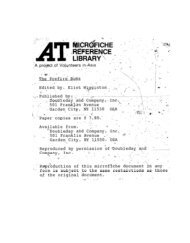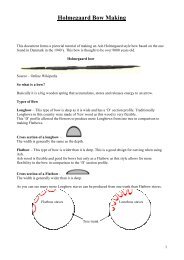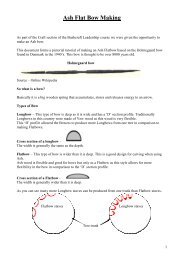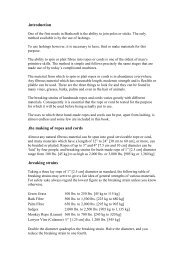Experiments on Knife Sharpening John D. Verhoeven ... - BushcraftUK
Experiments on Knife Sharpening John D. Verhoeven ... - BushcraftUK
Experiments on Knife Sharpening John D. Verhoeven ... - BushcraftUK
You also want an ePaper? Increase the reach of your titles
YUMPU automatically turns print PDFs into web optimized ePapers that Google loves.
optimum EW values found for afinal polish with 1 µm diam<strong>on</strong>dcompound. The ± numbersfollowing the average values arethe standard deviati<strong>on</strong> over the 4measurements. Polishing firstwith either the CrO or 6 micr<strong>on</strong>diam<strong>on</strong>d compounds (blades 3-63and 8-63) did not producesignificantly different results.Table 6 Optimum EW values with diam<strong>on</strong>d polishBladenumberProcedureAvg.Min/MaxOverallAvg.3-63 10 b&f <strong>on</strong> 6 µm D + 5 b&f <strong>on</strong> 1 µm D 0.18/0.34 0.266-63 11 b&f <strong>on</strong> 1 µm D 0.20/0.42 0.317-63 7 b&f <strong>on</strong> 1 µm D 0.20/0.38 0.298-63 6 b&f <strong>on</strong> CrO + 5 b&f <strong>on</strong> 1 µm D 0.34/0.45 0.39Overall Average min. = 0.23 ± 0.07 micr<strong>on</strong>sOverall Average max. = 0.40 ± 0.05 micr<strong>on</strong>sOverall Average = 0.31 ± 0.06 micr<strong>on</strong>sGillette 0.17/0.48 0.32The Gillette blade used as a standard above was also analyzed here with the sameprocedure as that employed for the Table 6 blades and it gave the results shown at thebottom of the table. So the edge width values obtained here are comparable to that of thisrazor blade. (Note: The EW values obtained here for the Gillette blade were a bit smallerthan those given <strong>on</strong> p. 6, where the average EW = 0.40. This difference is, however,within the standard deviati<strong>on</strong> of ± 0.06 micr<strong>on</strong>s reported in Table 6.)Comparing the EW values measured <strong>on</strong> blades pre-ground with either 220 grit or1000 grit wheels to the results of the pre-ground 600 grit blades of Table 6 found nosignificant changes, providing and adequate number of b&f passes were made. Bladesexamined after different numbers of b&f passes revealed that a minimum number of 12 to15 passes was necessary to produce face smoothness that removed most all of thecoarsest abrasive grooves from extending up to the cutting edge. Figure 48 illustrates theeffect of increasing the number of b&f passes from 4 to 10 <strong>on</strong> a blade pre-ground with600 grit wheels. The results for both the CrO compound and the diam<strong>on</strong>d compoundswas essentially the same, a minimum of 12 to 15 passes was best to remove the deepestabrasi<strong>on</strong> grooves from extending up to the cutting edge.A few blades were final polished with <strong>on</strong>ly the CrO compound and with <strong>on</strong>ly the6 micr<strong>on</strong> diam<strong>on</strong>d. In both cases it was found that the EW values were higher than thoseof Table 6 by around 0.1 to 0.2 micr<strong>on</strong>s.Sets of 2 blades were polished <strong>on</strong> both 1 micr<strong>on</strong> diam<strong>on</strong>d and CrO wheels withthe polishing angle increase over the pre-ground angle, ∆β, changed from 3 degrees to 5-6 degrees. The results of this study agreed with that of that presented in Secti<strong>on</strong> 5:Values of ∆β = 5-6 degrees gave slightly smaller EW values than found for ∆β = 3degrees.41








